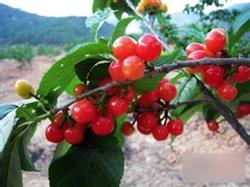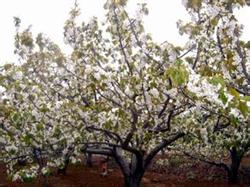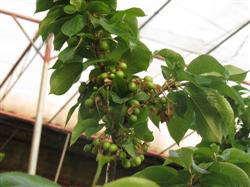Post-harvest management of big cherry

The technical management of sweet cherry trees after fruit harvest is very important, because at this time, the tree consumes a lot of nutrients stored in the tree through the early process of leaf expansion, shoot tapping, flowering, fruit setting to fruit growth and development, and enters the nutrition accumulation stage of photosynthesis after fruit harvest. The output was well managed during this period. Its techniques include summer pruning, thinning of overdense branches, chemical control, fertilization, disease prevention and pest control and so on. 1. Reasonable summer pruning and timely chemical control 1.1 after harvest, those who have grown dense branches, thin and weak branches, whiplash branches and diseases and insect pests should be thinned or cut short, so as to open the light path, enrich the branches and reduce unnecessary consumption. it is beneficial to flower bud differentiation and branch maturation. It is mainly aimed at upper strong trees and closed trees, which should be carried out from top to bottom. The trees with too many upper branches should not be thinned in one step, and should be carried out twice, with 1-2 large branches each time, with an interval of 1 month; the weak and ineffective branches behind the inner chamber should be removed at one time; the over-dense shoots on the back should be removed at one time; one elongated shoot, one or two heavy coring shoots from the extended branches should be retained, and the rest should be removed. The intuitive standard for a reasonable number of branches and leaves is that when the sun shines directly on the tree crown, the ground light and shadow coefficient is 30% and 40%. 1.2 twisting, coring and twisting is to twist 180 °on the vigorous growing branches and competitive branches during semi-Lignification, weaken their growth, promote flower bud differentiation and transform into fruiting branches. Those who are still growing vigorously after twisting should be continuously gently removed from the heart to inhibit growth. Gently plucking the extended shoot can ease the tree potential, but the secondary shoot should be extended uniaxially after coring. Heart-picking: heart-picking is to remove the young part of the tip before the new tip is lignified, which is called heart-picking. It is the most widely used method in summer pruning of sweet cherries. The heart-picking of young trees can promote the germination of more branches and promote the formation of flower buds. It can save nutrition, improve fruit setting rate and fruit quality in early fruit stage and full fruit stage. Heart extraction can be divided into mild heart extraction, moderate heart extraction and severe heart extraction. Mild coring: only the top 5cm was removed, and only 1 or 2 new shoots could germinate and grow after coring. If the growth is controlled in 10~20cm, continuous slight coring can form fruiting branches. Moderate coring: the purpose is to promote multi-branches, when the new shoots grow above 40cm, remove more than 15cm, generally can germinate 3-4 branches. Heavy coring: when the branches grow above 40cm, leaving 15cm around can not only promote branches, but also make the lower buds sprout into short branches or leaf clusters, forming small fruiting branches. The length of coring and retaining branches should be determined according to the planting space of branches and the different uses of branches. As a backbone branch, the remaining branch is longer and should be above 40cm. When the new shoots grow longer, but the remaining branches are shorter, and the coring part is semi-Lignified, it is necessary to use scissors to trim the shoots. The effect of pruning is stronger than that of picking the heart. 1.3 pull the strong branches to the place where there is space to make up for the lack of backbone branches. It can accelerate the forming, delay the growth of branches, improve the lighting of inner hall, and promote flower bud differentiation. In the vertical direction, the main branches should be kept at 80-90 °, the overlapping branches can be pulled horizontally to the appropriate direction, and the upper and lower spacing of the main branches in the same direction should reach 80-100cm. 1.4 timely chemical control can not restrain the growth of prosperous trees after taking various summer pruning measures, it is necessary to timely spray 200-300 times paclobutrazol or 180 times PBO to control, according to the principle of half a month interval, only spraying shoots, generally spraying 2-3 times can get a better inhibitory effect. 2. Fertilizing in time and increasing tree reserve are usually carried out from the end of May to the first ten days of June, that is, within half a month after fruit harvest. Because the flower bud differentiation begins about 10 days after sweet cherry fruit is picked. The kind of fertilizer should be the quick-acting fertilizer which contains many kinds of nutrients. Such as mature human feces and urine water, cooked bean cake water, compound fertilizer and other organic and inorganic fertilizers containing a variety of elements. Its dosage depends on the type of heat energy and fertilizer. Results the general amount of fertilizer used for big trees is: rotten human manure and urine water, about 70 kg per tree (or 100 kg of mature pig manure water), and 1.5-2 kg per fruiting tree if compound fertilizer is used. Radial ditch application can also be used. 2.1 early application of base fertilizer should be in early September. At this time, the soil temperature is still high, and the root system can absorb sufficient nutrients at the second growth peak, and after ditching and cutting roots, it will promote the growth of many capillary roots. adequate storage of nutrients is a favorable guarantee for flower bud development, flowering and fruit setting, and the first rapid growth of fruit in the coming year. 2.2 the furrow was opened with basic fertilizer and the furrow was deep 40cm, 60-100cm wide, and the rotation between plants and rows was carried out. According to the goal of fruit yield 2000kg per mu, 2500-3000kg of rotten pure chicken manure, duck manure and pig manure were applied, mixed with high quality potassium sulfate compound fertilizer 70-80kg, mixed with soil and watered. The orchard slices deficient in iron and zinc were mixed with ferrous sulfate 25kg, zinc sulfate 15kg and organic fertilizer and applied. 2.3 within one week after foliar topdressing is harvested, combined with pest control, 0.3% Mel 0.5% potassium dihydrogen phosphate + 0.5% urea is sprayed twice to delay defoliation and promote the development of flower buds. 3. Control of diseases and insect pests 3.1The critical period for the control of mites and caterpillars was before Grain in Beard, avermectins could be sprayed, and caterpillars could spray pyrethroids pesticides. Peach leafhopper, also known as floating and sunken seed, is the main disease in the late growth stage of cherry. From July to September, the damage is the most serious. The damaged peach leaves appear yellow and white spots, and when serious, the whole leaves wither and yellow and fall off early, resulting in tree weakness, affecting the formation of flowers, and reducing the annual yield in the coming year. It can spray 20% fenvalerate EC 3000 times and 2.5% deltamethrin 25003000 times. In addition, methamphetamine, imidacloprid, avermectin and thiazuron can also be selected for prevention and control. During the period of prevention and control of bacterial perforation and leaf spot disease, 1000 times of agricultural streptomycin plus 45600 times of methyl topiramate or Dasheng MMI can be sprayed alternately at intervals of 10-15 days to prevent the disease. and significantly improve the smoothness of the fruit surface. 3.3 the gum flowing part of the tree should be removed in time after rain, coated with raw lime powder or methyl topiramate paste and wrapped with film. Check frequently and prevent and cure as it occurs. 4. after irrigation fruit harvest, flower bud differentiation is mainly carried out, in order to restore the tree body and ensure the normal flower bud differentiation, fertilization and irrigation should be applied immediately after harvest, but the amount of irrigation water is wet over the ground, and short-term drought after irrigation is beneficial to flower bud differentiation. Irrigation should not be excessive in the growing season of sweet cherries, and the soil moisture is generally kept at about 70% of the field capacity. 5. Drought prevention and drainage sweet cherry root distribution layer is relatively shallow, afraid of drought and waterlogging, small water should be watered frequently during drought to keep soil water content stable. Sweet cherry trees are most afraid of stagnant water, after waterlogging, yellow leaves, wilting, dead branches, poor tree growth, reduced yield, or even dead trees, resulting in irregular orchards and low yield. Aggravate the occurrence of rheumatosis. Therefore, the sweet cherry orchard must be drained smoothly to ensure that it can be drained within 2 hours after rain, and try to drain manually to ensure that there is no stagnant water in the garden. The drainage ditch should be dug well before the rainy season, and the plots with a history of waterlogging should be ridged and cultivated, but every time the soil is cultivated, the 5cm should be ridged gradually.
- Prev

Fertilization techniques of Big Cherry
The main fertilization techniques and methods of big cherry are as follows: first, fertilization technology 1. The application of base fertilizer in autumn is generally carried out in late August. The application of base fertilizer in autumn is the peak of root growth in autumn, which is beneficial to the absorption of nutrients.
- Next

Humidity Control Technology of Cherry in greenhouse
From mulching to harvesting, the soil relative humidity is required to be 60% Mel 80%, and 80% is required from pre-germination to early flowering. During the germination period, the soil moisture of 20-40 cm is dispersed according to the clump of the soil. After flowering, the soil relative humidity should be 60% and 70% of the relative humidity. Air humidity, maintenance phase from covered shed to germination period.
Related
- Moge, come on! The staff of the peasant association in the producing area of cantaloupe were frightened when the crowd gathered.
- Causes and Solutions of low Fruit setting rate of Apple
- Symptoms and control measures of passion fruit virus disease
- Fruit growing lesson: how do apple orchards keep high yields?
- Can you build orchards in the mountains? What are the pros and cons?
- How to manage the coloring period of Crisson grape?
- This paper introduces the processing technology of two kinds of fig products.
- How much is a month for retired teachers in rural areas by 2020?
- How can strawberry planting increase sugar content? We should pay attention to management in many aspects.
- What are the cultivation techniques on how to improve the yield of golden fruit?

